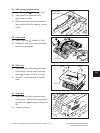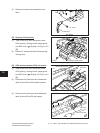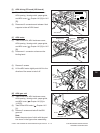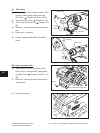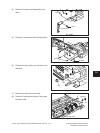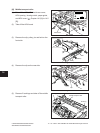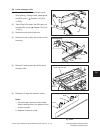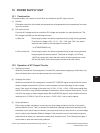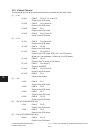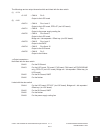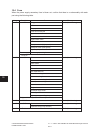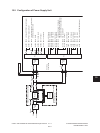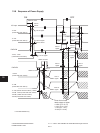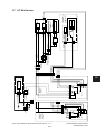
e-STUDIO350/352/353/450/452/453
POWER SUPPLY UNIT
15
15 - 1
© 2003 - 2008 TOSHIBA TEC CORPORATION All rights reserved
15. POWER SUPPLY UNIT
15.1 Construction
ThepowersupplyunitconsistsofanAClterandinsulationtypeDCoutputcircuits.
(1) AClter
Eliminates noise from the outside and prevents the noise generated by the equipment from leak-
ing to the outside.
(2) DC output circuits
Converts AC voltage input from outside to DC voltage and supplies it to each electric part. The
DC voltage is divided into the following two lines.
a. Main line : Power supply used in the entire equipment during image forming process.
Five kinds of voltage (+3.3V, +5.1V, +12V, –12V* and +24V*) are output
when the main switch of the equipment is turned ON.
*: e-STUDIO350/450 only
b. Door switch line : Power supply used in the entire equipment during image forming process,
being supplied via the door switch. Two kinds of voltage (+5.1VD and
+24VD) are output only when the main switch of the equipment is turned
ON and two doors (front cover and jam access cover) are closed.
15.2 Operation of DC Output Circuits
(1) Starting line output
When the main switch of the equipment is turned ON, power starts supplying to all the lines only
when two doors (front cover and jam access cover) are closed.
(2) Stopping line output
When the main switch of the equipment is turned OFF, PWR-DN signal is output after the instan-
taneous outage insurance time (20 ms or more) elapses and then the supply of each voltage
stops. If the supply of voltage of the main line (+3.3VA, +5.1VA, +12VA, -12VA) stops earlier than
the 24V line does, it may cause the damage of the electron device on each control circuit. To pre-
vent this, the supply of these voltages stops after the PWR-DN signal is output and the minimum
retaining time (+3.3VA/+5.1VA: 50 ms or more, +12VA/-12VA: 5 ms or more) elapses.
(3) Output protection
Each output system includes an overcurrent and overvoltage protection circuits (a fuse and in-
ternal protection circuit). This is to prevent the defectives (damage or abnormal operation of the
secondary circuit) which may be caused by an overcurrent due to a short circuit or an overvoltage
due to a short circuit between different voltages. If the protection circuit is activated (except the
case the fuse is blown out), remove the causes such as short-circuit. Turn ON the power again 1
minute later to clear the overcurrent protection.
05/11



